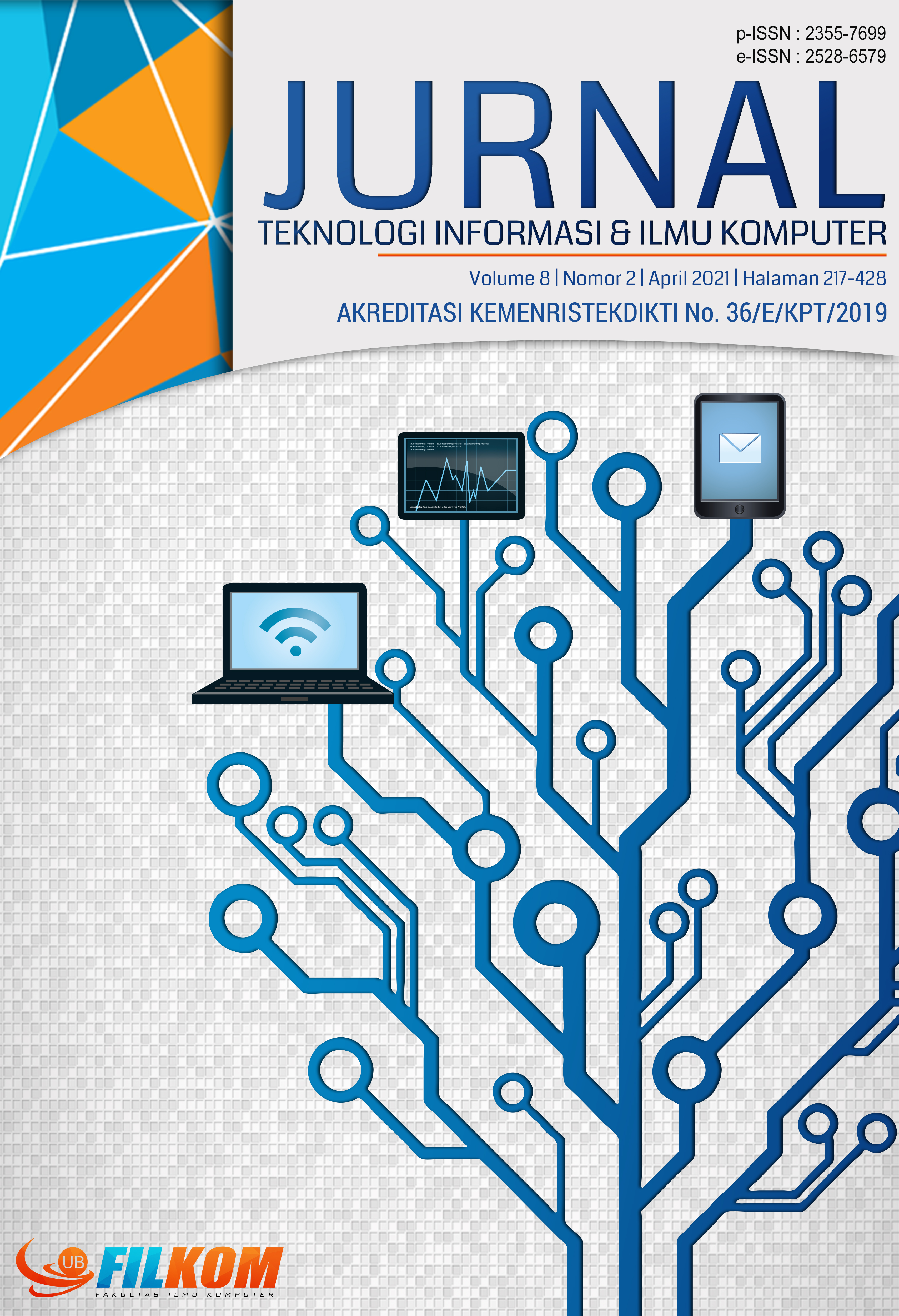Klasifikasi Tingkat Dehidrasi Berdasarkan Kondisi Urine, Denyut Jantung dan Laju Pernapasan
DOI:
https://doi.org/10.25126/jtiik.2021824379Abstrak
Dehidrasi merupakan suatu kondisi ketika tubuh kekurangan cairan. Secara umum terdapat tiga tingkatan dehidrasi, yaitu dehidrasi ringan, sedang dan berat. Tingkatan dehidrasi berat sangat berbahaya bagi penderitanya, bahkan dapat mengakibatkan kematian. Untuk mencegah terjadinya tingkatan dehidrasi yang berbahaya, maka diperlukan pendeteksian secara dini agar penderita dehidrasi segera mendapatkan penanganan yang cepat dan tepat. Terdapat beberapa parameter yang dapat digunakan untuk mendeteksi dehidrasi, diantaranya warna dan kadar ammonia pada urine, denyut jantung dan laju pernapasan. Pada penelitian ini, dirancang sebuah sistem klasifikasi tingkatan dehidrasi berdasarkan empat parameter tersebut dengan menggunakan metode klasifikasi k-nearest neighbor. Sistem yang dirancang mampu memberikan kemudahan untuk melakukan pemeriksaan secara mandiri dan mendapatkan hasil klasifikasi tingkat dehidrasi secara real-time. Dataset yang digunakan dalam penelitian ini berjumlah 75 data yang didapatkan dari pasien diare yang menjalani perawatan di Rumah Sakit. Data tersebut sudah memiliki tingkatan dehidrasi berdasarkan diagnosis dari dokter. Dari hasil pengujian yang telah dilakukan, metode k-nearest neighbor memiliki tingkat akurasi terbaik pada penggunaan nilai k=5 dan k=7 dengan nilai akurasi sebesar 96%.
Abstract
Dehydration is a condition when the body lacks of fluids, caused by the amount of fluid released by the body is greater than the fluids that enters the body. Dehydration is divided into three levels, mild, moderate and severe. Severe dehydration is very dangerous and can even lead to death in patients. To prevent dangerous levels of dehydration, early detection is needed to provide fast and precise treatment to patients. There are several parameters that can be used to detect dehydration, such as color and ammonia levels in urine, heart rate and respiratory rate. This paper designed a system to classify dehydration levels based on these four parameters using k-nearest neighbor classification method. The system is designed to be easy to use independently and provides real-time classification results. There are 75 datasets used in this paper, obtained from diarrhea patients in a hospital in Malang. Each data already has a label in the form of dehydration level based on the doctor’s diagnosis. From the test result, k-nearest neighbor has the best classification accuracy at k=5 and k=7 with the accuracy of 96%.
Downloads
Referensi
ANDREWS, J.R., LEUNG, D.T., AHMED, S., MALEK, M.A., AHMED, D., BEGUM, Y.A., QADRI, F., AHMED, T., FARUQUE, A.S.G. & NELSON, E.J., 2017. Determinants of Severe Dehydration from Diarrheal Disease at Hospital Presentation: Evidence from 22 Years of Admissions in Bangladesh. PLOS Neglected Tropical Disease, vol. 11, pp. 1-16.
BALAMURUGAN, M., NANCY, A. & VIJAYKUMAR, S., 2017. Alzheimer’s Disease Diagnosis by Using Dimensionality Reduction Based on KNN Classifier. Biomedical & Pharmacology Journal, vol. 10, pp. 1823-1830.
BANUAG, L.C. & SALVA, J.K.G., 2019. Development of a Patient Monitoring System for Hospital Wards Employing Zigbee Technology and CAN Protocol. World Symposium on Communication Engineering, pp. 112-116.
BUDIMAN, F., RIVAI, M. & NUGROHO, M.A., 2019. Monitoring and Control System for Ammonia and pH Levels for Fish Cultivation Implemented on Raspberry Pi 3B. International Seminar on Intelligent Technology and Its Application, pp. 68-73.
FUKUSHIMA, Y., SANO, Y., ISOZAKI, Y., ENDO, M., TOMODA, T., KITAMURA, T., SATO, T., KAMIJO, Y., HAGA, Y. & YODA, T., 2018. A Pilot Clinical Evaluation of Oral Mucosal Dryness in Dehydrated Patients using a Moisture-Checking Device. Clinical and Experimental Dental Research, vol. 5, pp. 116-120.
GUNAWAN, A.A.S., BRANDON, D., PUSPA, V.D. & WIWEKO, B., 2018. Development of Urine Hydration System Based on Urine Color and Support Vector Machine. International Conference on Computer Science and Computational Intelligence, pp. 481-489.
KIM, K.B. & KWAK, Y.S., 2019. Dehydration Affects Exercise-Induced Asthma and Anaphylaxis. Journal of Exercise Rehabilitation, vol. 15, pp. 647-650.
KOLEVA, G., 2019. Dehydration at Seafarers – Prevention, Symptoms and Approaches. Scientific Bulletin of Naval Academy, vol. 22, pp. 78-82.
MAULANA, R., SYAUQY, D. & AMANI, R.Z., 2017. Dehydration Level Detection System Based on Urine Condition. International Conference on Signal Processing Systems, pp. 207-210.
PANIE, G.I.E. & MUTIARA, A.B., 2018. Development of Robotic Arm for Color Based Goods Sorten in Factory Using TCS3200 Sensor with a Web-Based Monitoring System. International Conference on Informatics and Computing, pp. 1-6.
ROY, R.K., HAZARIKA, N., SINGH, H.K. & BEZBORUAH, T., 2018. A Novel Method for Measurement of Linear Displacement by Using Extension Spring and Flex Sensor. International Conference on Power, Energy and Environment: Towards Smart Technology, pp. 1-9.
SEVEREYN, E., VELASQUEZ, J., PERPINAN, G., HERRERA, H., PACHECO, M. & WONG, S., 2016. Heart Rate Variability Analysis During a Dehydration Protocol on Athletes. Symposium on Signal Processing, Images and Artificial Vision, pp. 1-7.
SHAHEEN, N.A., ALQAHTANI, A.A., ASSIRI, H., ALKHODAIR, R. & HUSSEIN, M.A., 2018. Public Knowledge of Dehydration and Fluid Intake Practices: Variation by Participants Characteristics. BMC Public Health, vol. 18, pp. 1346.
SINGH, A. & PANDEY, B., 2017. An Euclidean Distance Based KNN Computational Method for Assessing Degree of Liver Damage. International Conference on Inventive Computation Technologies, pp. 1-4.
WILLIHNGANZ, M.J., GUREVITZ, S.L. & CLAYTON, B.D., 2020. Clayton’s Basic Pharmacology for Nurses. St. Louis: Elsevier.
Unduhan
Diterbitkan
Terbitan
Bagian
Lisensi

Artikel ini berlisensi Creative Common Attribution-ShareAlike 4.0 International (CC BY-SA 4.0)
Penulis yang menerbitkan di jurnal ini menyetujui ketentuan berikut:
- Penulis menyimpan hak cipta dan memberikan jurnal hak penerbitan pertama naskah secara simultan dengan lisensi di bawah Creative Common Attribution-ShareAlike 4.0 International (CC BY-SA 4.0) yang mengizinkan orang lain untuk berbagi pekerjaan dengan sebuah pernyataan kepenulisan pekerjaan dan penerbitan awal di jurnal ini.
- Penulis bisa memasukkan ke dalam penyusunan kontraktual tambahan terpisah untuk distribusi non ekslusif versi kaya terbitan jurnal (contoh: mempostingnya ke repositori institusional atau menerbitkannya dalam sebuah buku), dengan pengakuan penerbitan awalnya di jurnal ini.
- Penulis diizinkan dan didorong untuk mem-posting karya mereka online (contoh: di repositori institusional atau di website mereka) sebelum dan selama proses penyerahan, karena dapat mengarahkan ke pertukaran produktif, seperti halnya sitiran yang lebih awal dan lebih hebat dari karya yang diterbitkan. (Lihat Efek Akses Terbuka).












